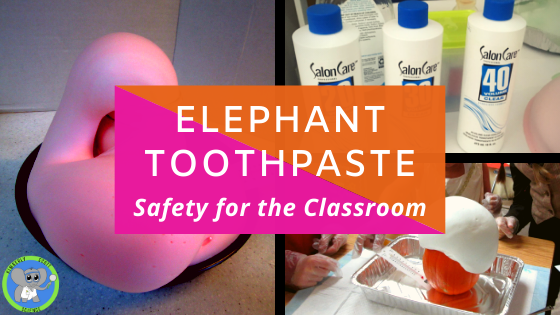Elephant Toothpaste Safety: The Original Reaction Compared To The Kid Friendly Version
The chemical reaction known as elephant toothpaste is quite impressive and often garners a lot of attention online. However, it's important to note that it's not safe to perform this experiment with students unless you are a qualified and trained chemistry teacher.
I'm a bit confused. I've seen kids performing this reaction in videos and for science fairs. Are they doing a simplified version of it? It seems like they're having just as much fun and getting more involved. Read more to find out how you can do it in the classroom.
The original elephant toothpaste reaction uses a 30% concentration of hydrogen peroxide that is very strong and causes chemical and thermal burns. It is not available to the public. It must be carefully packaged and shipped because hydrogen peroxide is not very stable. That is why the reaction works so well.
The original reaction catalyst is potassium iodide. Yeast will not work with this high concentration of hydrogen peroxide. This is a substance best to leave to the chemistry teacher. If you are trained and have access, give it a try. (Outside, preferably with your audience far enough away.) Make sure you use all safety precautions.
If you want students actively involved, switch over to the kid-friendly version.
It uses a lower concentration of hydrogen peroxide that you can purchase in a salon supply store. Students will still need safety goggles and gloves. It can burn/sting on your skin. If the higher concentrations make you nervous, use the 4-6% drug store version. (You know, the classic brown bottle.) Still a good eruption.
The catalyst is yeast in the kid-friendly version. Yeast is easy to find and inexpensive. No hazards there! Just make sure your yeast is not expired.
The foam produced is just soap, oxygen, water, and yeast. Kids can touch the foam. Do not touch the inside or bottom of the container. It gets hot. The reaction does produce pure oxygen, which is flammable. In the kid-friendly version, it is a smaller amount. Just don't have a candle nearby, but why would you anyway.
It will also smell like you are baking bread from the yeast. The kids always find this interesting, and the change in smell is evidence of a chemical change.
List of Safety Supplies
- Goggles
- Rubber Gloves
- Lab Coat ( It looks cool and professional.)
- Tray to hold the container for the overflowing foam.
- MSDS Sheets for hydrogen peroxide, water, and yeast. Most schools require this. Click here to learn more.
- Paper towels for clean-up.
- We like to put puppy pads on our lab tables to catch spills.
Check out ways to expand this into a complete classroom unit.
Shop this Post







